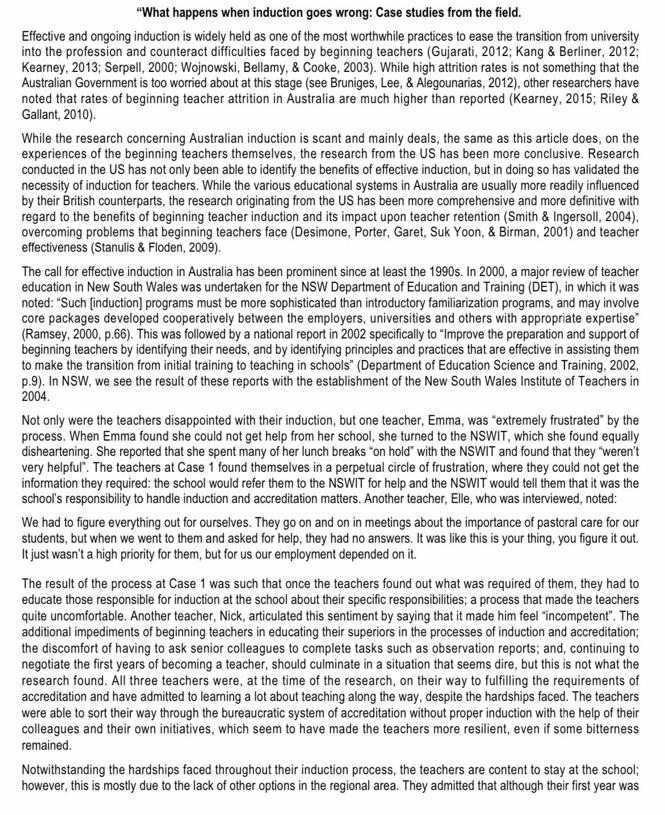Answered step by step
Verified Expert Solution
Question
1 Approved Answer
What happens when induction goes wrong: Case studies from the field. Effective and ongoing induction is widely held as one of the most worthwhile



"What happens when induction goes wrong: Case studies from the field. Effective and ongoing induction is widely held as one of the most worthwhile practices to ease the transition from university into the profession and counteract difficulties faced by beginning teachers (Gujarati, 2012; Kang & Berliner, 2012; Kearney, 2013; Serpell, 2000; Wojnowski, Bellamy, & Cooke, 2003). While high attrition rates is not something that the Australian Government is too worried about at this stage (see Bruniges, Lee, & Alegounarias, 2012), other researchers have noted that rates of beginning teacher attrition in Australia are much higher than reported (Kearney, 2015; Riley & Gallant, 2010). While the research concerning Australian induction is scant and mainly deals, the same as this article does, on the experiences of the beginning teachers themselves, the research from the US has been more conclusive. Research conducted in the US has not only been able to identify the benefits of effective induction, but in doing so has validated the necessity of induction for teachers. While the various educational systems in Australia are usually more readily influenced by their British counterparts, the research originating from the US has been more comprehensive and more definitive with regard to the benefits of beginning teacher induction and its impact upon teacher retention (Smith & Ingersoll, 2004), overcoming problems that beginning teachers face (Desimone, Porter, Garet, Suk Yoon, & Birman, 2001) and teacher effectiveness (Stanulis & Floden, 2009). The call for effective induction in Australia has been prominent since at least the 1990s. In 2000, a major review of teacher education in New South Wales was undertaken for the NSW Department of Education and Training (DET), in which it was noted: "Such [induction] programs must be more sophisticated than introductory familiarization programs, and may involve core packages developed cooperatively between the employers, universities and others with appropriate expertise" (Ramsey, 2000, p.66). This was followed by a national report in 2002 specifically to "Improve the preparation and support of beginning teachers by identifying their needs, and by identifying principles and practices that are effective in assisting them to make the transition from initial training to teaching in schools" (Department of Education Science and Training, 2002, p.9). In NSW, we see the result of these reports with the establishment of the New South Wales Institute of Teachers in 2004. Not only were the teachers disappointed with their induction, but one teacher, Emma, was "extremely frustrated" by the process. When Emma found she could not get help from her school, she turned to the NSWIT, which she found equally disheartening. She reported that she spent many of her lunch breaks "on hold" with the NSWIT and found that they "weren't very helpful". The teachers at Case 1 found themselves in a perpetual circle of frustration, where they could not get the information they required: the school would refer them to the NSWIT for help and the NSWIT would tell them that it was the school's responsibility to handle induction and accreditation matters. Another teacher, Elle, who was interviewed, noted: We had to figure everything out for ourselves. They go on and on in meetings about the importance of pastoral care for our students, but when we went to them and asked for help, they had no answers. It was like this is your thing, you figure it out. It just wasn't a high priority for them, but for us our employment depended on it. The result of the process at Case 1 was such that once the teachers found out what was required of them, they had to educate those responsible for induction at the school about their specific responsibilities; a process that made the teachers quite uncomfortable. Another teacher, Nick, articulated this sentiment by saying that it made him feel "incompetent". The additional impediments of beginning teachers in educating their superiors in the processes of induction and accreditation; the discomfort of having to ask senior colleagues to complete tasks such as observation reports; and, continuing to negotiate the first years of becoming a teacher, should culminate in a situation that seems dire, but this is not what the research found. All three teachers were, at the time of the research, on their way to fulfilling the requirements of accreditation and have admitted to learning a lot about teaching along the way, despite the hardships faced. The teachers were able to sort their way through the bureaucratic system of accreditation without proper induction with the help of their colleagues and their own initiatives, which seem to have made the teachers more resilient, even if some bitterness remained. Notwithstanding the hardships faced throughout their induction process, the teachers are content to stay at the school; however, this is mostly due to the lack of other options in the regional area. They admitted that although their first year was very difficult, the school is a nice place to work and teaching staff is collaborative and supportive. Nevertheless, the adversity these teachers faced in the early years of their career is exactly what effective induction is designed to prevent. The reality is that these teachers made it through those years without too much ill effect is a testament to their professional fortitude, rather than. Full article: What happens when induction goes wrong: Case studies from the field (tandfonline.com) (Accessed 28/4/21) *NSWIT (Australian government) Answer ALL the questions in this section. QUESTION 1 (20 Marks) With reference to the case study, the Australian Government is concerned about induction in teaching. You are appointed by the Department of Education in Australia to create an induction program for the teachers. QUESTION 2 (20 Marks) Making reference to the case study, critically discuss the benefits of Onboarding and Socialization for the teachers. SECTION B [60 Marks] Answer ANY THREE (3) questions in this section. QUESTION 3 [20 Marks] While your day-to-day duties make demands on your time, do not neglect your most important HR responsibility: helping your organization plan and manage changes essential to the organization's growth and future. You need to develop your change management and organizational diagnosis skills, so you'll be ready to aid major changes within your organization. Management Development. Change Management. Step out and become a change leader.(HR Daily Advisor, 2017https://www.humanresourcestoday.com/case-study/change-management/examples/) According to the abstract, Leaders need to 'step out and become a change leader'. Discuss an 8-step process that leaders can use for organizational change. In your discussion provide practical related examples to substantiate your answer. QUESTION 4 [20 Marks] To enhance online learning, organisations need to embrace E- learning. Discuss comprehensively the concept of Electronic learning and make use of practical examples to substantiate your response. QUESTION 5 [20 Marks] Organizational learning processes - across L&D, Executive Development, Leadership Development, and more of the roles in HR and talent management - are largely still rooted in both industrial era models and myths. We see practices that don't make sense, and we're not aligned with what we now know about how we think, work, and learn. And this is a problem for organizational success.( Organizational Learning Engineering Clark Quinn, 2016, https://www.elearninglearning.com/organizational-learning/problem/) Discuss the organisational practices and mechanisms that can help move an organisation towards becoming a learning organisation. QUESTION 6 [20 Marks] " An increasing number of company's view HRD as an important business imperative to enhance competitiveness and overall business performance. South African companies that use HRD as a strategic business strategy are likely to outperform their competitors who fail to do so (Meyer et.al, 2012)" Discuss the aspects that an HRD practitioner needs to embrace and understand to be both successful as well as effective in transitioning to a strategic partner. END OF PAPER
Step by Step Solution
★★★★★
3.42 Rating (165 Votes )
There are 3 Steps involved in it
Step: 1
Induction refers to the time when a newly qualified teacher in England or Wales is both supported and assessed to ensure that regulatory standards are met Although new teacher probation periods were a...
Get Instant Access to Expert-Tailored Solutions
See step-by-step solutions with expert insights and AI powered tools for academic success
Step: 2

Step: 3

Ace Your Homework with AI
Get the answers you need in no time with our AI-driven, step-by-step assistance
Get Started


